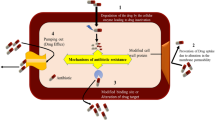Abstract
Purpose
There is increasing evidence that shigellosis is a predominantly sexually transmitted disease among men who have sex with men (MSM) and that infection with the human immunodeficiency virus (HIV) is a risk factor for shigellosis.
Methods
Retrospective analysis of antibiotic resistance profiles of Shigella species isolated from stool specimens of patients presenting with diarrhea from January 2010 to July 2012 in three German outpatient clinics specialized in HIV care.
Results
Among 79 cases of Shigella sonnei, 56 occurred in HIV-infected MSM, while 23 were observed in HIV-negative MSM. High resistance rates (>90 %) were found for doxycycline, tetracycline, aminoglycosides, all cephalosporins of first and second generations tested, and trimethoprim/sulfamethoxazole. In total, 54 % of cases were resistant to ciprofloxacin. Compared to negative subjects, HIV-infected MSM had a significantly higher rate of quinolone resistance. For ciprofloxacin, the resistance rates were 66 versus 24 %, respectively (p = 0.0016). Individual resistance patterns did not indicate that this was due to a limited outbreak. Rates of resistance to other antibiotics than quinolones showed no differences between HIV-infected and HIV-negative cases. No resistance was found for carbapenems or newer cephalosporins such as ceftriaxone.
Conclusions
The high rates of S. sonnei isolates resistant to quinolones and other traditional antibiotics are of concern. Innovative prevention efforts are urgently needed. The empirical use of quinolones in HIV-infected patients presenting with S. sonnei infection is no longer recommended.
Similar content being viewed by others
References
Niyogi SK. Shigellosis. J Microbiol. 2005;43:133–43.
Niyogi SK. Increasing antimicrobial resistance—an emerging problem in the treatment of shigellosis. Clin Microbiol Infect. 2007;13:1141–3.
Baer JT, Vugia DJ, Reingold AL, Aragon T, Angulo FJ, Bradford WZ. HIV infection as a risk factor for shigellosis. Emerg Infect Dis. 1999;5:820–3.
Aragón TJ, Vugia DJ, Shallow S, Samuel MC, Reingold A, Angulo FJ, Bradford WZ. Case–control study of shigellosis in San Francisco: the role of sexual transmission and HIV infection. Clin Infect Dis. 2007;44:327–34.
Robert Koch Institut. Epidemiologisches Bulletin. 27 September 2010/Nr. 38. 2010.
Marcus U, Zucs P, Bremer V, Hamouda O, Prager R, Tschaepe H, Futh U, Kramer M. Shigellosis—a re-emerging sexually transmitted infection: outbreak in men having sex with men in Berlin. Int J STD AIDS. 2004;15:533–7.
Sivapalasingam S, Nelson JM, Joyce K, Hoekstra M, Angulo FJ, Mintz ED. High prevalence of antimicrobial resistance among Shigella isolates in the United States tested by the National Antimicrobial Resistance Monitoring System from 1999 to 2002. Antimicrob Agents Chemother. 2006;50:49–54.
Vrints M, Mairiaux E, Van Meervenne E, Collard JM, Bertrand S. Surveillance of antibiotic susceptibility patterns among Shigella sonnei strains isolated in Belgium during the 18-year period 1990 to 2007. J Clin Microbiol. 2009;47:1379–85.
Gu B, Cao Y, Pan S, Zhuang L, Yu R, Peng Z, Qian H, Wei Y, Zhao L, Liu G, Tong M. Comparison of the prevalence and changing resistance to nalidixic acid and ciprofloxacin of Shigella between Europe–America and Asia–Africa from 1998 to 2009. Int J Antimicrob Agents. 2012;40:9–17.
Gaudreau C, Ratnayake R, Pilon PA, Gagnon S, Roger M, Lévesque S. Ciprofloxacin-resistant Shigella sonnei among men who have sex with men, Canada, 2010. Emerg Infect Dis. 2011;17:1747–50.
Folster JP, Pecic G, Bowen A, Rickert R, Carattoli A, Whichard JM. Decreased susceptibility to ciprofloxacin among Shigella isolates in the United States, 2006 to 2009. Antimicrob Agents Chemother. 2011;55:1758–60.
Ruiz J, Pons MJ, Gomes C. Transferable mechanisms of quinolone resistance. Int J Antimicrob Agents. 2012;40:196–203.
Dalhoff A. Resistance surveillance studies: a multifaceted problem—the fluoroquinolone example. Infection. 2012;40:239–62.
Enders M, Turnwald-Maschler A, Regnath T. Antimicrobial resistance of Neisseria gonorrhoeae isolates from the Stuttgart and Heidelberg areas of southern Germany. Eur J Clin Microbiol Infect Dis. 2006;25:318–22.
Jacoby GA. Mechanisms of resistance to quinolones. Clin Infect Dis. 2005;41:S120–6.
World Health Organization (WHO). International note on antibiotics in the management of shigellosis. Wkly Epidemiol Rec. 2004;79:202–3.
Conflict of interest
None.
Author information
Authors and Affiliations
Corresponding author
Rights and permissions
About this article
Cite this article
Hoffmann, C., Sahly, H., Jessen, A. et al. High rates of quinolone-resistant strains of Shigella sonnei in HIV-infected MSM. Infection 41, 999–1003 (2013). https://doi.org/10.1007/s15010-013-0501-4
Received:
Accepted:
Published:
Issue Date:
DOI: https://doi.org/10.1007/s15010-013-0501-4




